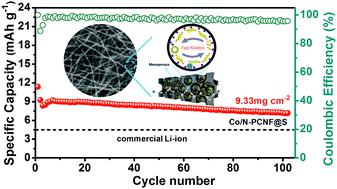当前位置:
X-MOL 学术
›
Nanoscale Horiz.
›
论文详情
Our official English website, www.x-mol.net, welcomes your
feedback! (Note: you will need to create a separate account there.)
Rational integration of spatial confinement and polysulfide conversion catalysts for high sulfur loading lithium-sulfur batteries.
Nanoscale Horizons ( IF 8.0 ) Pub Date : 2020-02-08 , DOI: 10.1039/c9nh00663j Qingfei Zhang 1 , Zhensong Qiao , Xinrui Cao , Baihua Qu , Jin Yuan , Tian-E Fan , Hongfei Zheng , Jinqing Cui , Shunqing Wu , Qingshui Xie , Dong-Liang Peng
Nanoscale Horizons ( IF 8.0 ) Pub Date : 2020-02-08 , DOI: 10.1039/c9nh00663j Qingfei Zhang 1 , Zhensong Qiao , Xinrui Cao , Baihua Qu , Jin Yuan , Tian-E Fan , Hongfei Zheng , Jinqing Cui , Shunqing Wu , Qingshui Xie , Dong-Liang Peng
Affiliation

|
Spatial confinement is a desirable successful strategy to trap sulfur within its porous host and has been widely applied in lithium-sulfur (Li-S) batteries. However, physical confinement alone is currently not enough to reduce the lithium polysulfide (Li2Sn, 4 ≤ n ≤ 8, LIPSs) shuttle effect with sluggish LIPS-dissolving kinetics. In this work, we have integrated spatial confinement with a polar catalyst, and designed a three-dimensional (3D) interconnected, Co decorated and N doped porous carbon nanofiber (Co/N-PCNF) network. This Co/N-PCNF film serves as a freestanding host for sulfur trapping, which could effectively facilitate the infiltration of electrolyte and electron transport. In addition, the polar Co species possess strong chemisorption with LIPSs, catalyzing their reaction kinetics as well. As a result of this rational design and integration, the Co/N-PCNF@S cathode with a sulfur loading of 2 mg cm-2 exhibits a high initial discharge capacity of 878 mA h g-1 at 1C, and maintains a discharge capacity of 728 mA h g-1 after 200 cycles. Even with high sulfur loading of 9.33 mg cm-2, the cathode still keeps a stable areal capacity of 7.16 mA h cm-2 at 0.2C after 100 cycles, which is much higher than the current areal capacity (4 mA h cm-2) of commercialized lithium-ion batteries (LIBs). This rational design may provide a new approach for future development of high-density Li-S batteries with high sulfur loading.
中文翻译:

用于高硫负载锂硫电池的空间限制和多硫化物转化催化剂的合理整合。
空间限制是将硫捕获在其多孔主体中的理想成功策略,并且已被广泛应用于锂硫(Li-S)电池。但是,仅靠物理限制目前不足以降低LIPS溶解动力学,从而减少多硫化锂(Li2Sn,4≤n≤8,LIPSs)的穿梭效应。在这项工作中,我们将空间限制与极性催化剂集成在一起,并设计了一个三维(3D)互连,Co装饰和N掺杂的多孔碳纳米纤维(Co / N-PCNF)网络。这种Co / N-PCNF膜可作为硫捕集的独立主体,可以有效地促进电解质的渗透和电子传输。此外,极性Co物种对LIPS具有强的化学吸附作用,也催化了它们的反应动力学。通过这种合理的设计和集成,硫负载为2 mg cm-2的Co / N-PCNF @ S阴极在1C时具有878 mA h g-1的高初始放电容量,并保持了放电容量200个周期后的728 mA h g-1的电流。即使在硫载量为9.33 mg cm-2的情况下,经过100个循环后,阴极在0.2C下仍保持7.16 mA h cm-2的稳定面容量,这远高于当前的面容量(4 mA h cm-2 )的商业化锂离子电池(LIB)。这种合理的设计可能为将来开发高硫负荷的高密度锂电池提供新的方法。即使在9.33 mg cm-2的高硫负载下,阴极在100次循环后仍在0.2C下保持7.16 mA h cm-2的稳定面容量,这远高于当前的面容量(4 mA h cm-2 )的商业化锂离子电池(LIB)。这种合理的设计可能为将来开发高硫负荷的高密度锂电池提供新的方法。即使在9.33 mg cm-2的高硫负载下,阴极在100次循环后仍在0.2C下保持7.16 mA h cm-2的稳定面容量,这远高于当前的面容量(4 mA h cm-2 )的商业化锂离子电池(LIB)。这种合理的设计可能为将来开发高硫负荷的高密度锂电池提供新的方法。
更新日期:2020-02-08
中文翻译:

用于高硫负载锂硫电池的空间限制和多硫化物转化催化剂的合理整合。
空间限制是将硫捕获在其多孔主体中的理想成功策略,并且已被广泛应用于锂硫(Li-S)电池。但是,仅靠物理限制目前不足以降低LIPS溶解动力学,从而减少多硫化锂(Li2Sn,4≤n≤8,LIPSs)的穿梭效应。在这项工作中,我们将空间限制与极性催化剂集成在一起,并设计了一个三维(3D)互连,Co装饰和N掺杂的多孔碳纳米纤维(Co / N-PCNF)网络。这种Co / N-PCNF膜可作为硫捕集的独立主体,可以有效地促进电解质的渗透和电子传输。此外,极性Co物种对LIPS具有强的化学吸附作用,也催化了它们的反应动力学。通过这种合理的设计和集成,硫负载为2 mg cm-2的Co / N-PCNF @ S阴极在1C时具有878 mA h g-1的高初始放电容量,并保持了放电容量200个周期后的728 mA h g-1的电流。即使在硫载量为9.33 mg cm-2的情况下,经过100个循环后,阴极在0.2C下仍保持7.16 mA h cm-2的稳定面容量,这远高于当前的面容量(4 mA h cm-2 )的商业化锂离子电池(LIB)。这种合理的设计可能为将来开发高硫负荷的高密度锂电池提供新的方法。即使在9.33 mg cm-2的高硫负载下,阴极在100次循环后仍在0.2C下保持7.16 mA h cm-2的稳定面容量,这远高于当前的面容量(4 mA h cm-2 )的商业化锂离子电池(LIB)。这种合理的设计可能为将来开发高硫负荷的高密度锂电池提供新的方法。即使在9.33 mg cm-2的高硫负载下,阴极在100次循环后仍在0.2C下保持7.16 mA h cm-2的稳定面容量,这远高于当前的面容量(4 mA h cm-2 )的商业化锂离子电池(LIB)。这种合理的设计可能为将来开发高硫负荷的高密度锂电池提供新的方法。











































 京公网安备 11010802027423号
京公网安备 11010802027423号